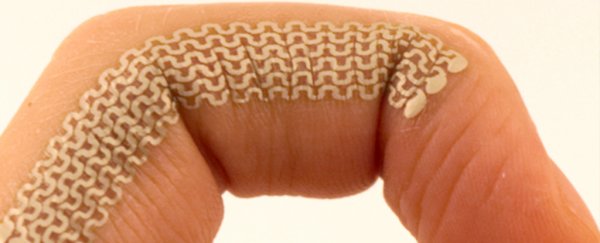Depending on how often you use your phone, chances are you know its screen like the back of your hand.
Researchers have now combined to two, allowing you to control your electronic devices with a stick-on circuit called 'SkinMarks' that can turn your knuckles into a keypad and your freckles into glowing toggles.
Working with Google, scientists from Saarland University in Germany printed circuits made of conductive ink on decal paper commonly used for stick-on temporary tattoos, and then hooked them up to a small, open source piece of hardware called an Arduino microcontroller.
By tinkering with the thickness and type of ink and the flexibility of the paper, the researchers managed to find a variety of ways these tattoos could function by being touched, squeezed, or bent.
"We make use of the elastic properties of the skin, including bending and stretching," researcher Jürgen Steimle told New Scientist's Matt Reynolds.
Electroluminescent ink was even added to some of the designs to provide the wearer with a dynamic display.
To put their designs to the test, the researchers identified five categories of body 'landmarks':
- Bumps, bends, and curves caused by the skeleton
- Wrinkles and other skin grooves
- Contrasts in elasticity, such as the webbing between fingers
- Visual marks, such as freckles, tattoos, and moles
- Removable accessories, such as rings and watches.
"We demonstrated novel interactions on each of these landmarks to advance on-body interaction towards more detailed, highly curved and challenging body locations," the researchers write in their report.
Their work is yet to be peer-reviewed, so we'll have to take their word on it for now about how effective the technology actually is, but the results will be presented to the scientific community in May at the ACM CHI Conference on Human Factors in Computing Systems in Denver.
It doesn't take much to imagine how this kind of technology could be used – adjust the volume of your smartphone's music by sliding one finger over another, or have a loved-one on speed dial by pressing a sequence of freckles.
Bending and flexing fingers could also offer a variety of functions, depending on whether your hand is making a fist, is flat, or splayed.
Take a look at some of the designs and the process the team went through to make their tattoos below:
Using stick-on circuits to interact with the body isn't itself all that new, with previous research developing them for medical applications, such as monitoring a patient's heart rate or sleeping pattern.
What makes this work stand out though is the simplicity of the design process, potentially opening the way for artists and amateur engineers to tinker with building their own stick-on circuits.
In this case, making the tattoos themselves only took about 3 hours, but there's hope that one day similar circuits could be printed using home equipment in under a minute.
One small problem the team faced was the accidental input you'd get from unintentional bumps and swipes, but it's likely these small issues could be ironed out by figuring out the best gestures – which could help avoid you accidentally butt-dialling your mother by scratching the wrong mole.
"Now we've tested the technological feasibility, the next step is to look at implementing it in a practical way," researcher Martin Weigel explained to New Scientist.
In time, improvements in flexible batteries and smaller processors could help make these ultra-thin interfaces virtually indistinguishable from our own bodies.
It's hard to know where wearable technology is going in the future – Google announced an end to its Glass Explorer Program way back in 2015, while the famous Kickstarter success story Pebble smartwatch company was purchased by Fitbit last year after a shocking drop in share price.
For all of its promise, spreading our smart devices around our body still seems to be more future fad than modern fashion.
Yet technology that can make wearable circuits cheaper and more accessible to your home tinkerer could be just the thing we need to turn our tattoos into blinking pieces of interactive art.
